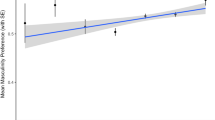Abstract
Recent studies investigating the relationship between sexual desire and sexual attraction have found that heterosexual women’s reported sexual desire is positively correlated with their reported attraction to both own- and opposite-sex individuals, but that heterosexual men’s reported sexual desire is positively correlated with their reported attraction to opposite-sex individuals only. These findings have led to the proposal that sexual desire is a generalized energizer of sexual attraction in heterosexual women (i.e., influences women’s attraction to both men and women), but only energizes heterosexual men’s sexual attraction to women. Here we show that heterosexual men’s scores on the Sexual Desire Inventory-2 were positively correlated with their preferences for exaggerated sex-typical shape cues in opposite-sex, but not own-sex, faces. Together with previous research showing that heterosexual women’s reported sexual desire is positively correlated with their preferences for exaggerated sex-typical shape cues in both own- and opposite-sex faces, our findings present novel converging evidence for sex-specific relationships between sexual desire and attractiveness judgments of own- and opposite-sex individuals.

Similar content being viewed by others
References
DeBruine, L. M., Jones, B. C., Little, A. C., Boothroyd, L. G., Perrett, D. I., Penton-Voak, I. S., et al. (2006). Correlated preferences for facial masculinity and ideal or actual partner’s masculinity. Proceedings of the Royal Society of London B, 273, 1355–1360.
DeBruine, L. M., Jones, B. C., Smith, F. G., & Little, A. C. (2010). Are attractive men’s faces masculine or feminine? The importance of controlling confounds in face stimuli. Journal of Experimental Psychology: Human Perception and Performance, 36, 751–758.
Fraccaro, P. J., Feinberg, D. R., DeBruine, L. M., Little, A. C., Watkins, C. D., & Jones, B. C. (2010). Correlated male preferences for femininity in female faces and voices. Evolutionary Psychology, 8, 447–461.
Giargiari, T. D., Mahaffey, A. L., Craighead, W. E., & Hutchison, K. E. (2005). Appetitive responses to sexual stimuli are attenuated in individuals with low levels of sexual desire. Archives of Sexual Behavior, 34, 547–556.
Johnston, V. S., Hagel, R., Franklin, M., Fink, B., & Grammer, K. (2001). Male facial attractiveness: Evidence for a hormone-mediated adaptive design. Evolution and Human Behavior, 22, 251–267.
Jones, B. C., DeBruine, L. M., Little, A. C., Conway, C. A., Welling, L. L. M., & Smith, F. G. (2007). Sensation seeking and men’s face preferences. Evolution and Human Behavior, 28, 439–446.
Jones, B. C., DeBruine, L. M., Main, J. C., Little, A. C., Welling, L. L. M., Feinberg, D. R., et al. (2010). Facial cues of dominance modulate the short-term gaze-cuing effect in human observers. Proceedings of the Royal Society of London B, 277, 617–624.
King, B. E., & Allgeier, E. R. (2000). The Sexual Desire Inventory as a measure of sexual motivation in college students. Psychological Reports, 86, 347–350.
Kraut, R., Olson, J., Banaji, M., Bruckman, A., Cohen, J., & Couper, M. (2004). Psychological research online: Report on Board of Scientific Affairs’ Advisory Group on the conduct of research on the Internet. American Psychologist, 59, 105–177.
Lippa, R. A. (2006). Is high sex drive associated with increased sexual attraction to both sexes? It depends on whether you are male or female. Psychological Science, 17, 46–52.
Lippa, R. A. (2007). The relation between sex drive and sexual attraction to men and women: A cross-national study of heterosexual, bisexual, and homosexual men and women. Archives of Sexual Behavior, 36, 209–222.
Lippa, R. A., Patterson, T. M., & Marelich, W. D. (2010). Looking at and longing for male and female “swimsuit models”: Men are much more category specific than women. Social Psychological and Personality Science, 1, 238–245.
Rhodes, G. (2006). The evolution of facial attractiveness. Annual Review of Psychology, 57, 199–226.
Rowland, D. A., & Perrett, D. I. (1995). Manipulating facial appearance through shape and color. IEEE Computer Graphics and Applications, 15, 70–76.
Smith, F. G., Jones, B. C., & DeBruine, L. M. (2010). Individual differences in empathizing and systemizing predict variation in face preferences. Personality and Individual Differences, 49, 655–658.
Spector, I. P., Carey, M. P., & Steinberg, L. (1996). The Sexual Desire Inventory: Development, factor structure, and evidence of reliability. Journal of Sex and Marital Therapy, 22, 175–190.
Steiger, J. H. (1980). Tests for comparing elements of a correlation matrix. Psychological Bulletin, 87, 245–251.
Tiddeman, B., Burt, M., & Perrett, D. (2001). Prototyping and transforming facial textures for perception research. IEEE Computer Graphics and Applications, 21, 42–50.
Welling, L. L. M., Jones, B. C., & DeBruine, L. M. (2008). Sex drive is positively associated with women’s preferences for sexual dimorphism in men’s and women’s faces. Personality and Individual Differences, 44, 161–170.
Welling, L. L. M., Jones, B. C., DeBruine, L. M., Conway, C. A., Law Smith, M. J., Little, A. C., et al. (2007). Raised salivary testosterone in women is associated with increased attraction to masculine faces. Hormones and Behavior, 52, 156–161.
Author information
Authors and Affiliations
Corresponding author
Rights and permissions
About this article
Cite this article
Jones, B.C., Little, A.C., Watkins, C.D. et al. Reported Sexual Desire Predicts Men’s Preferences for Sexually Dimorphic Cues in Women’s Faces. Arch Sex Behav 40, 1281–1285 (2011). https://doi.org/10.1007/s10508-010-9721-1
Received:
Revised:
Accepted:
Published:
Issue Date:
DOI: https://doi.org/10.1007/s10508-010-9721-1




